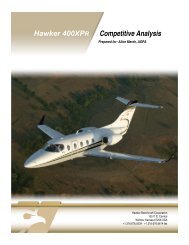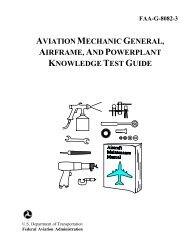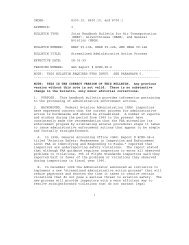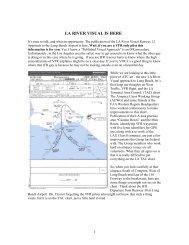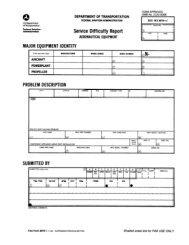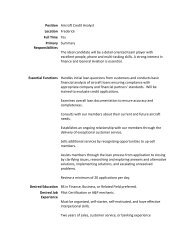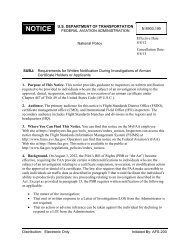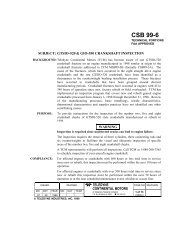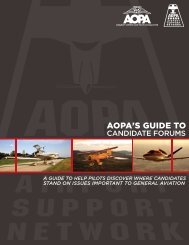2008 Nall Report - Aircraft Owners and Pilots Association
2008 Nall Report - Aircraft Owners and Pilots Association
2008 Nall Report - Aircraft Owners and Pilots Association
Create successful ePaper yourself
Turn your PDF publications into a flip-book with our unique Google optimized e-Paper software.
Section TITLE<br />
Appendix<br />
General Aviation Safety vs. Airlines<br />
GA accident rates have always been higher than<br />
airline accident rates. People often ask about the<br />
reasons for this disparity. There are several:<br />
• Variety of missions – GA pilots conduct a wider<br />
range of operations. Some operations, such as aerial<br />
application (crop-dusting, in common parlance) <strong>and</strong><br />
banner towing, have inherent mission-related risks.<br />
• Variability of pilot certificate <strong>and</strong> experience<br />
levels – All airline flights are crewed by at least one<br />
ATP (airline transport pilot), the most dem<strong>and</strong>ing<br />
rating. GA is the training ground for most pilots, <strong>and</strong><br />
while the GA community has its share of ATPs, the<br />
community also includes many new <strong>and</strong> low-time pilots<br />
<strong>and</strong> a great variety of experience in between.<br />
• Limited cockpit resources <strong>and</strong> flight support –<br />
Usually, a single pilot conducts GA operations,<br />
<strong>and</strong> the pilot typically h<strong>and</strong>les all aspects of the<br />
flight, from flight planning to piloting. Air carrier<br />
operations require at least two pilots. Likewise,<br />
airlines have dispatchers, mechanics, loadmasters,<br />
<strong>and</strong> others to assist with operations <strong>and</strong> consult<br />
with before <strong>and</strong> during a flight.<br />
• Greater variety of facilities – GA operations<br />
are conducted at about 5,300 public-use <strong>and</strong> 8,000<br />
private-use airports, while airlines are confined to<br />
only about 600 of the larger public-use airports.<br />
Many GA-only airports lack the precision approaches,<br />
long runways, approach lighting systems,<br />
<strong>and</strong> the advanced services of airline-served airports.<br />
(There are also another 6,000 GA-only l<strong>and</strong>ing<br />
areas that are not technically airports, such as<br />
heliports <strong>and</strong> seaplane bases.)<br />
• More takeoffs <strong>and</strong> l<strong>and</strong>ings – During takeoffs<br />
<strong>and</strong> l<strong>and</strong>ings aircraft are close to the ground <strong>and</strong><br />
in a more vulnerable configuration than in other<br />
phases of flight. On a per hour basis, GA conducts<br />
many more takeoffs <strong>and</strong> l<strong>and</strong>ings than either air<br />
carriers or the military.<br />
• Less weather-tolerant aircraft – Most GA<br />
aircraft cannot fly over or around weather the<br />
way airliners can, <strong>and</strong> they often do not have the<br />
systems to avoid or cope with hazardous weather<br />
conditions, such as ice.<br />
What Is General Aviation?<br />
Although GA is typically characterized by recreational<br />
flying, it encompasses much more. Besides providing<br />
personal, business, <strong>and</strong> freight transportation, GA<br />
supports diverse activities such as law enforcement,<br />
forest fire fighting, air ambulance, logging, fish <strong>and</strong><br />
wildlife spotting, <strong>and</strong> other vital services. For a breakdown<br />
of GA activities <strong>and</strong> their accident statistics, see<br />
“Type of Operation” on page 11.<br />
What Does General Aviation Fly?<br />
General aviation aircraft are as varied as their pilots<br />
<strong>and</strong> the types of operations flown. The following<br />
aircraft categories <strong>and</strong> classes are included in<br />
each year’s <strong>Nall</strong> <strong>Report</strong>:<br />
• Piston single-engine<br />
• Piston multiengine<br />
• Turboprop single-engine<br />
• Turboprop multiengine<br />
• Experimental<br />
• Amateur-built<br />
• Turbojet<br />
What Does General Aviation Fly?<br />
Air Taxi General Aviation<br />
Piston single-engine 1,751 145,818<br />
Piston multiengine 1,483 17,854<br />
Turboprop single-engine 582 3,477<br />
Turboprop multiengine 882 4,574<br />
Turbojet 2,681 7,704<br />
Helicopter 1,954 7,613<br />
Experimental 107 23,121<br />
Light Sport 0 6,066<br />
TOTAL 9,440 216,227<br />
Figure 45<br />
31



